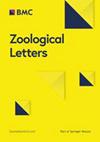Brood success of sex-role-reversed pheasant-tailed jacanas: the effects of social polyandry, seasonality, and male mating order
IF 1.7
3区 生物学
Q2 ZOOLOGY
引用次数: 0
Abstract
Multiple mating by avian females may increase hatching and overall brood success; however, reproductive effort and parental investment are costly, and females may be gradually depleted, with lowered outputs over time. Thus, males in social polyandry systems may differ greatly in their reproductive gains. In the present study, we investigated the reproductive outputs of social polyandrous and sex-role-reversed pheasant-tailed jacanas, Hydrophasianus chirurgus, to assess the effects of polyandry, seasonality, and male mating order on breeding success. Female jacanas produced multiple clutches, either by leaving two or more clutches with an individual male (22%), or by mating with two or more males (78%). The polyandrous females laid both the first and second clutches earlier and showed a breeding period more than twice as long as that of monandrous females. Both polyandry and seasonality affected the fate of a clutch, where clutches from polyandrous females and the early season had higher hatching and brood success rates, but the number of polyandrous females declined over the season. Polyandrous females not only laid more clutches and eggs, and gained more hatchlings and fledglings, but also achieved higher per-clutch outputs and hatching rates than monandrous females. In polyandry groups, males gained higher total hatchlings and fledglings, although not total clutches or eggs, than males in monandry or bi-andry groups. Moreover, males in polyandry groups achieved higher hatchlings and fledglings per clutch and higher hatching and brood success rates. In polyandry groups, the first-mating males obtained more clutches, eggs, and hatchlings; however, they did not have higher success rates, nor total fledglings and per-clutch outputs, than males who mated later. Overall, the results indicate a selective advantage of polyandry for the jacanas studied, particularly in the early breeding season. This advantage, however, differs both between the sexes and intra-sexually, suggesting strong connections with certain ecological/environmental conditions in addition to the jacanas’ own quality.性别角色逆转的雉尾鸦雀的育雏成功率:社会多雄性、季节性和雄性交配顺序的影响
鸟类雌性的多次交配可能会提高孵化率和整体育雏成功率;然而,繁殖努力和亲本投资是昂贵的,雌性可能会逐渐耗竭,随着时间的推移产出降低。因此,在社会多雄性系统中,雄性的生殖收益可能会有很大差异。在本研究中,我们调查了社会多雄性和性别角色逆转的雉尾鸦雀(Hydrophasianus chirurgus)的繁殖产出,以评估多雄性、季节性和雄性交配顺序对繁殖成功率的影响。雌性雉尾鸦雀通过与一只雄性鸦雀交配(22%)或与两只或两只以上雄性鸦雀交配(78%)产下多胎。多雄性雌鸟产第一和第二胎的时间都较早,繁殖期是单雄性雌鸟的两倍多。多雄性和季节性都会影响一窝雌鸟的命运,多雄性雌鸟和季节性较早的一窝雌鸟的孵化率和育雏成功率较高,但多雄性雌鸟的数量随着季节的变化而减少。多雄性雌鸟不仅产卵数和卵数更多,孵出的幼鸟和雏鸟数量更多,而且每窝产量和孵化率也高于单雄性雌鸟。在多雄性群体中,雄鸟获得的孵化雏鸟和羽化雏鸟总数比单雄性或双雄性群体中的雄鸟多,但孵化雏鸟和羽化雏鸟的总数却比单雄性或双雄性群体中的雄鸟少。此外,多雄性群体中的雄性每窝孵出的幼体和雏鸟数量较多,孵化率和育雏成功率也较高。在多雄性群体中,先交配的雄性获得了更多的窝、卵和孵化雏鸟;但是,它们的成功率、雏鸟总数和每窝产雏数并不比后交配的雄性高。总体而言,研究结果表明,对所研究的鸦雀而言,多雄性繁殖具有选择性优势,尤其是在早期繁殖季节。然而,这种优势在性别间和性别内都存在差异,这表明除了槐树自身的质量外,还与某些生态/环境条件密切相关。
本文章由计算机程序翻译,如有差异,请以英文原文为准。
求助全文
约1分钟内获得全文
求助全文
来源期刊

Zoological Letters
Agricultural and Biological Sciences-Animal Science and Zoology
CiteScore
3.60
自引率
0.00%
发文量
12
审稿时长
10 weeks
期刊介绍:
Zoological Letters is an open access journal that publishes new and important findings in the zoological sciences. As a sister journal to Zoological Science, Zoological Letters covers a wide range of basic fields of zoology, from taxonomy to bioinformatics. We also welcome submissions of paleontology reports as part of our effort to contribute to the development of new perspectives in evolutionary zoology. Our goal is to serve as a global publishing forum for fundamental researchers in all fields of zoology.
 求助内容:
求助内容: 应助结果提醒方式:
应助结果提醒方式:


